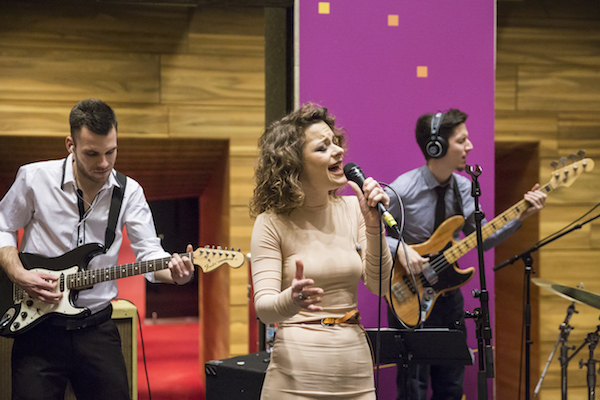Oct 28, 2025 10:47 AM
In Memoriam: Jack DeJohnette, 1942–2025
Jack DeJohnette, a bold and resourceful drummer and NEA Jazz Master who forged a unique vocabulary on the kit over his…

Balázs Bágyi (right), president of the Hungarian Jazz Association, performs with his New Quartet during the Hungarian Jazz Showcase and Talent Exchange, which ran Feb. 3–5.
(Photo: Kotschy Gabor)Hungary staked its claim as jazz capital of Central Europe February 3–5 as the arts center Müpa Budapest—comparable to the Kennedy Center in Washington, D.C., —staged its 10th annual Jazz Showcase and Talent Exchange.
The weekend’s smoothly organized events demonstrated both an international level of musicianship and a distinctly native flavor. There was a competition in which nine locally based acts vied for future gigs, performing afternoon sets in informal spaces for crowds of 60 to 100 listeners; an impressive exhibit of Sánta Istvan Csaba’s photos of American jazz masters; two panel discussions; and three evening concerts of regionally-rooted stars, held in Müpa’s well-designed theaters.

Photo: A festival attendee peruses the exhibit of Sánta Istvan Csaba’s photos of American jazz masters. (Credit: Posztos Janos)
The stylistic variety of the Showcase/Talent Exchange contestants was exemplified by its vocal acts. The Cintia Horváth Quintet dramatically interpreted standards and ballads. Mariann Németh Szabo’s quartet Girly Groove served up bouncy pop tunes. Petra Kész in her trio Cymbal Rush delivered an exotic mélange of extended vocal techniques and range, electronics effects and original song forms. Sultry soul-singer Janka Vörös fronted e-Series, a well-rehearsed yet funky band.
Photo: Cintia Horváth (right) with members of her quintet perform at the Hungary Jazz Showcase/Talent Exchange. (Credit: Kotschy Gabor)
All the women sang in English, giving a colorful lilt to the familiar lyrics of “My Foolish Heart,” “Superstition,” “On Broadway” and Betty Wright’s “Cleanup Woman,” among other hits. Horváth and Vörös were both abetted by saxophone and guitar soloists, as well as solid bass and drum support. Kész offset her gleeful chants, wild wailing and loops with a pianist who gave his improvisations a classical touch and a drummer who kept simple yet effective time.
The non-vocal groups were equally diverse. The trio Jazzbois created a synth keyboard-guitar-drums electro-groove. Drummer Toni Snétberger’s Roma (gypsy) quartet featuring guitarist Csaba Danyi and pianist Zsolt Farkas tapped the guitar-piano vibe of Wes Montgomery’s recordings with Wynton Kelly, playing “Jordu” and “Impressions.” Alto saxophonist Gábor Baris’ folksy quartet Gino’s B Version, featuring the invigorating drummer Akos Benkó, earned a special award from the Hungarian Jazz Association.

Photo: Janka Vörös (center) and members of her e-Series band. (Credit: Palyi Zsofia)
The prestigious jury award—conferred by a panel of Hungarian guitar hero Gyula Babos, U.K. presenter/producer/manager/administrator John Cumming, Budapest Jazz Club programmer Péter Pallai, Budapest cultural journalist Kornél Zipernovszky and this reporter—went to the quartet of alto and soprano saxophonist Tamås Ludányi, who, with impassioned pianist Aron Tälos, personalized Coltrane’s compositions and freedoms.
Polling of the Showcase/Exchange audience over three days resulted in the crowd’s award going to singer Vörös. Her prize is to headline a free, open air Müpa concert next summer. The Zemplén Festival, held in June in the wine-producing northeastern province of Hungary, rewarded Cintia Horváth and pianist Gyula Balogh’s quartet with the promise of upcoming appearances.
The main concerts on Feb. 3 and 4 took place in Müpa’s 459-seat Festival Theater. Hungarian-Slovakian drummer David Hodek, with Americans Paul Cornish (piano) and Joshua Crumbly (bass), played chilled-out versions of repertoire by J Dilla and Herbie Hancock (“Maiden Voyage”).
Drummer Balázs Bágyi, president of the Hungarian Jazz Association, drove his New Quartet. Chinese trumpeter Li Xiaochuan was a special guest, interweaving his tightly focused sound in loose cohesion with saxophonist Sandor Lakatos on one composition alternating 5/4 and 6/8 sections, as well as another titled “Shanghai Blues” and a jazz waltz.
The weekend climaxed in a sold-out gala concert in Müpa’s 1600-seat Béla Bartok National Concert Hall. Attila László, faculty member of the local Franz Liszt Academy of Music, conducted the 18-piece Senior Big Band, starting with “I Got Rhythm” as arranged by Rob McConnell. Then the orchestra accompanied winners previous Jazz Showcase/Talent Exchanges in spotlit turns.
For the finale, tenor saxophonist Gábor Bolla provided powerful obbligato for singers Juli Fábián, Veronika Harcsa and Bálint Gájer, harmonizing on “Almost Like Being In Love” from the 1947 Broadway musical “Brigadoon.” These Central Europeans swung hard, with precision, polish, and complete commitment to jazz in the contemporary, global idiom. DB

Jack DeJohnette boasted a musical resume that was as long as it was fearsome.
Oct 28, 2025 10:47 AM
Jack DeJohnette, a bold and resourceful drummer and NEA Jazz Master who forged a unique vocabulary on the kit over his…

D’Angelo achieved commercial and critical success experimenting with a fusion of jazz, funk, soul, R&B and hip-hop.
Oct 14, 2025 1:47 PM
D’Angelo, a Grammy-winning R&B and neo-soul singer, guitarist and pianist who exerted a profound influence on 21st…

Kandace Springs channeled Shirley Horn’s deliberate phrasing and sublime self-accompaniment during her set at this year’s Pittsburgh International Jazz Festival.
Sep 30, 2025 12:28 PM
Janis Burley, the Pittsburgh International Jazz Festival’s founder and artistic director, did not, as might be…

Jim McNeely’s singular body of work had a profound and lasting influence on many of today’s top jazz composers in the U.S. and in Europe.
Oct 7, 2025 3:40 PM
Pianist Jim McNeely, one of the most distinguished large ensemble jazz composers of his generation, died Sept. 26 at…

Drummond was cherished by generations of mainstream jazz listeners and bandleaders for his authoritative tonal presence, a defining quality of his style most apparent when he played his instrument unamplified.
Nov 4, 2025 11:39 AM
Ray Drummond, a first-call bassist who appeared on hundreds of albums as a sideman for some of the top names in jazz…